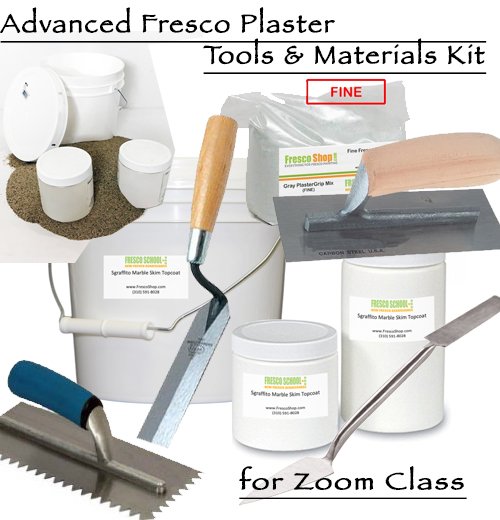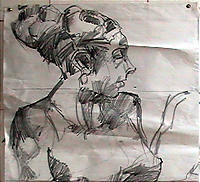 Cartoons are drawn on regular paper with pencil, graphite, charcoal, sepia chalk, etc., etc. The purpose of the cartoon is a thorough study and a final rendition of the composition, light, shadow and details of the future fresco. It is a preparatory drawing taken to the next level. Correctly done cartoon is a “stand along” artwork. Although optional in other painting mediums, Cartoon is essential when painting in Fresco not only as the main guideline for the transferring of the design onto freshly laid (fresco) plaster, but also as the main tool and method of understanding and orchestrating the steps for painting of the corresponding fresco.
Cartoons are drawn on regular paper with pencil, graphite, charcoal, sepia chalk, etc., etc. The purpose of the cartoon is a thorough study and a final rendition of the composition, light, shadow and details of the future fresco. It is a preparatory drawing taken to the next level. Correctly done cartoon is a “stand along” artwork. Although optional in other painting mediums, Cartoon is essential when painting in Fresco not only as the main guideline for the transferring of the design onto freshly laid (fresco) plaster, but also as the main tool and method of understanding and orchestrating the steps for painting of the corresponding fresco.
Preparation of the cartoon for the small fresco slightly differs from the preparation of the large fresco cartoon. In this article we discuss the small fresco cartoon. Since this article is intended for the general audience and/or beginner fresco artist it makes sense to illustrate the directions with the actual examples from our fresco workshops. During our workshops artists work from their own cartoons that they have to prepare at home prior to the class. Since many of our students have little or no practical experience in fresco we do not judge nor expect student’s cartoons to be perfect or even fully completed. However it will be helpful to establish some guidelines and explain the reasons behind them.
“Cartoon” – a full scale drawing of the future fresco.
Verne Busby flew from Canada to take our workshop in 2003, his cartoons, prepared for the class surpassed all our expectations to the point that we will use his work to illustrate this article. Please keep in mind we are not looking for or suggesting a particular style; on the contrary we hope that we will have a wide variety of “styles” (aka: modern, abstract, classic, representational or not) present during the class, so students can experience and share as many alternative methods and solutions to achieve desired results on the plaster as possible. The “guidelines” are directed to explain the “uni-system” of building up color, shadow, depth and contrast when working in fresco. In summary we can say that “Cartoon” is a “Checklist” of steps for the actual painting on wet plaster. You will repeat these steps one by one using color during the painting of the actual fresco. The result directly depends on how clear and how complete this “Checklist” is!
 For a small fresco initial design is rendered slightly larger than the final size of a fresco. As it is less constrained by the predefined measurement there is more freedom for the experiment with proportion and detail. Image will be “cropped” later to fit the frame. For the large fresco initial design usually “blown up” to fit the wall following with adding an refining of the details within somewhat permanent general composition.
For a small fresco initial design is rendered slightly larger than the final size of a fresco. As it is less constrained by the predefined measurement there is more freedom for the experiment with proportion and detail. Image will be “cropped” later to fit the frame. For the large fresco initial design usually “blown up” to fit the wall following with adding an refining of the details within somewhat permanent general composition.
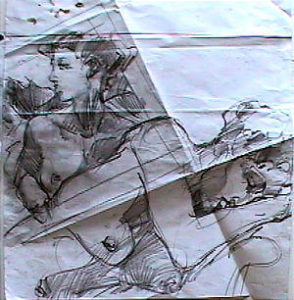 In this example, Artist has selected just a “headshot” to be painted (note the perimeter lines). It is clear that similar approach in working with large-fresco cartoon will be somewhat wasteful. However every detail needs to be defined and studied so often multiple full scale cartoons of the details and “angles” are produced and small “study” frescoes are painted before the final cartoon is completed.
In this example, Artist has selected just a “headshot” to be painted (note the perimeter lines). It is clear that similar approach in working with large-fresco cartoon will be somewhat wasteful. However every detail needs to be defined and studied so often multiple full scale cartoons of the details and “angles” are produced and small “study” frescoes are painted before the final cartoon is completed.
 In this example of the transfer-tracing Verne has adopted the initial cartoon to fit 16″X16″ tile that we use in the first painting sessions during our workshop. Note how the perimeter lines indicate outer edge of the fresco-tile and the painting area. The composition spills over the boundaries of the available area allowing for large detail without being “fragmented” resulting in a stand-along composition. Large, close up and larger-than-life objects are essential to understanding the technique of painting on plaster, especially at the beginning of learning fresco. For practice and study, elements must allow for continuous brush strokes and multiple transparent layers.
In this example of the transfer-tracing Verne has adopted the initial cartoon to fit 16″X16″ tile that we use in the first painting sessions during our workshop. Note how the perimeter lines indicate outer edge of the fresco-tile and the painting area. The composition spills over the boundaries of the available area allowing for large detail without being “fragmented” resulting in a stand-along composition. Large, close up and larger-than-life objects are essential to understanding the technique of painting on plaster, especially at the beginning of learning fresco. For practice and study, elements must allow for continuous brush strokes and multiple transparent layers.
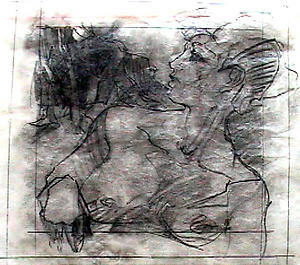 This example shows the tracing after it has been used for transfer (note the charcoal dust covering the rendition). After the final design area to be painted is finalized (see cartoon above) a tracing paper is laid over the selection and a clean outline is transferred which is then perforated and transferred onto fresh plaster using charcoal dust. The original cartoon is left clean and will be used as the main reference for the artist to build up the value range, shadows, volume, color intensity. it is virtually impossible to complete a fresco without developing cartoon first – remember you will not have time to do it on plaster as well as you will not be able to “paint over” the incorrectly placed shadows. Similar to watercolor fresco paints are generally transparent.
This example shows the tracing after it has been used for transfer (note the charcoal dust covering the rendition). After the final design area to be painted is finalized (see cartoon above) a tracing paper is laid over the selection and a clean outline is transferred which is then perforated and transferred onto fresh plaster using charcoal dust. The original cartoon is left clean and will be used as the main reference for the artist to build up the value range, shadows, volume, color intensity. it is virtually impossible to complete a fresco without developing cartoon first – remember you will not have time to do it on plaster as well as you will not be able to “paint over” the incorrectly placed shadows. Similar to watercolor fresco paints are generally transparent.
 This is a completed 24’X24″ fresco, at the originally planned size (see cartoon at the beginning of the article).
This is a completed 24’X24″ fresco, at the originally planned size (see cartoon at the beginning of the article).
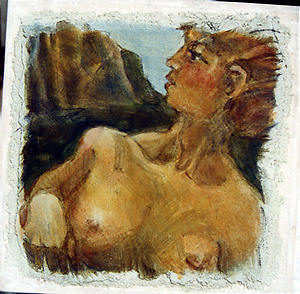 For this fresco the original cartoon has been adjusted (cropped) to fit 16’X16″ size (note that the detail has been enlarged considerably to fill the tile). This adjustment was made because the original design had too many small details, too many for that size of a fresco. At this stage a large amount of small details would have not allowed the student to experience the process of painting on wet plaster to the extend it was needed to understand the specifics of the technique.
For this fresco the original cartoon has been adjusted (cropped) to fit 16’X16″ size (note that the detail has been enlarged considerably to fill the tile). This adjustment was made because the original design had too many small details, too many for that size of a fresco. At this stage a large amount of small details would have not allowed the student to experience the process of painting on wet plaster to the extend it was needed to understand the specifics of the technique.
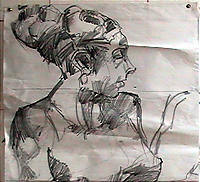 Cartoon
Cartoon
Note the shadows, highlighted areas, the accents and depth of the mid and dark tones – during the making of the cartoon is when you revise and finalize these relationships – during the painting you are “playing with color”, letting the pure expression to move your brush. You must be free from the “technical/structural worries” during the painting process – all that has to be established and refined before the brush hits the plaster – in the cartoon!
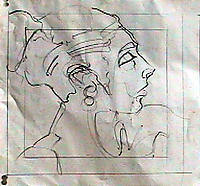 Tracing
Tracing
Note that only shape-defining lines – the outlines and edges have been transferred, just the boundaries of the forms and values.
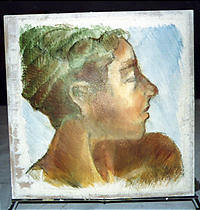 Fresco
Fresco
These frescoes are the first ever frescoes painted by Verne Busby, such success for the first time is greatly due to the perfect understanding and preparation of the cartoon.


